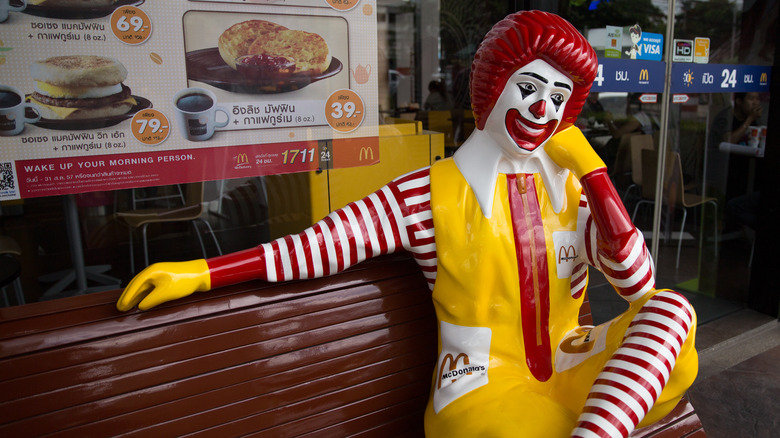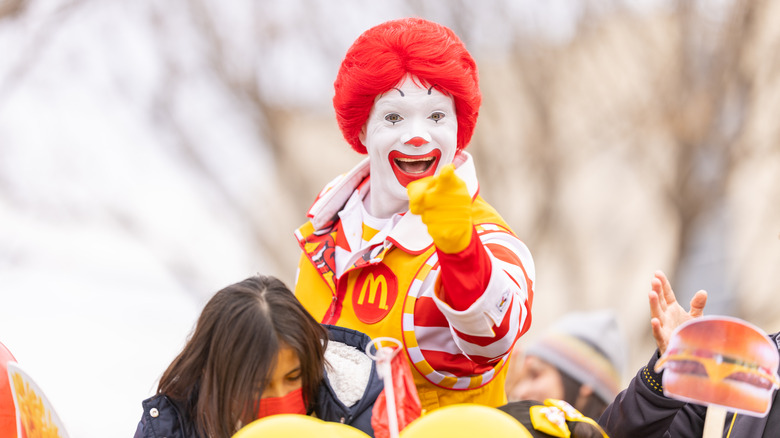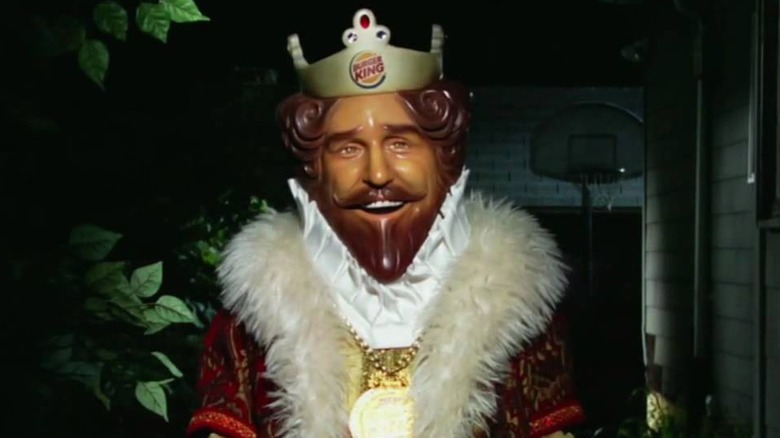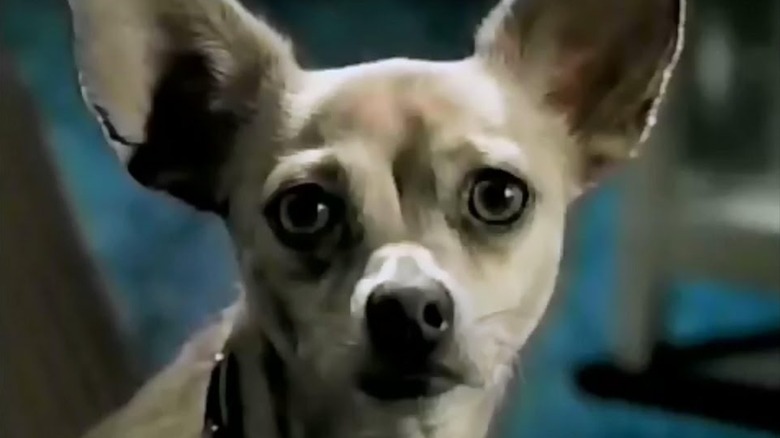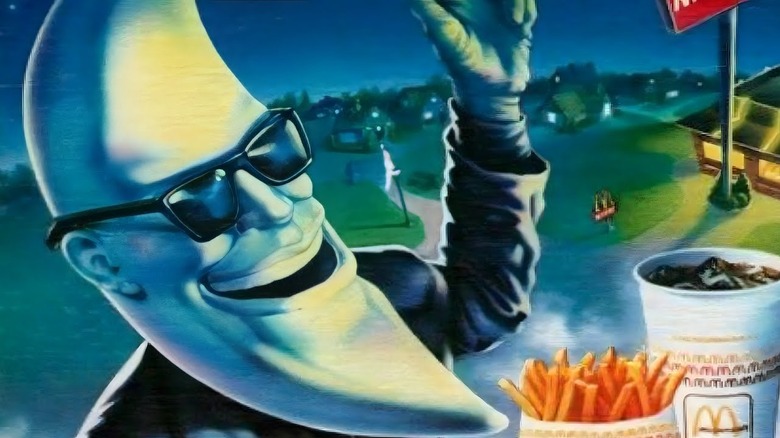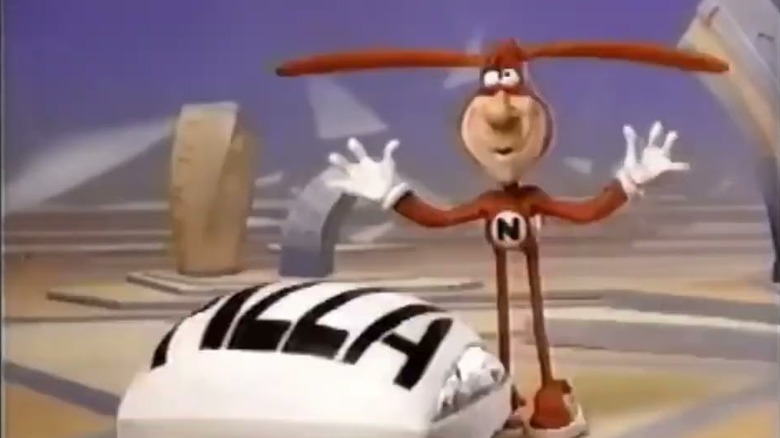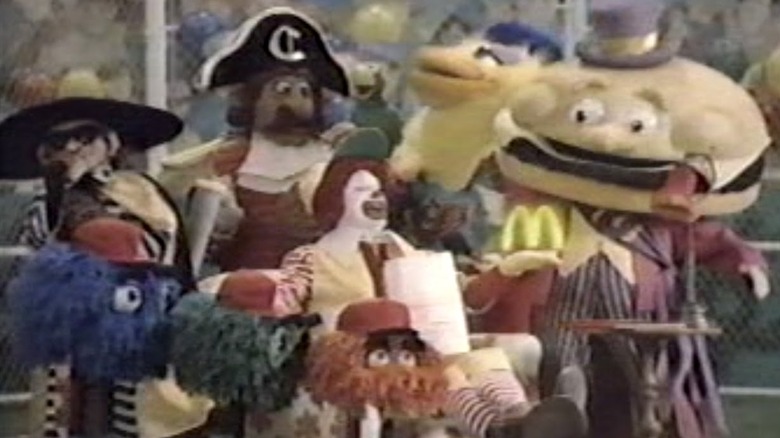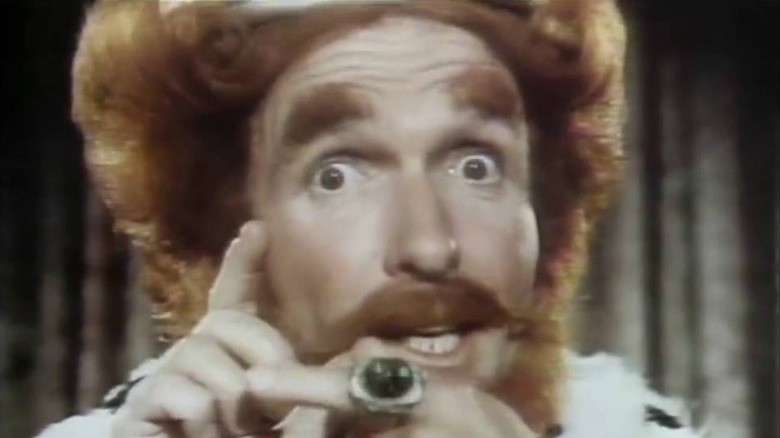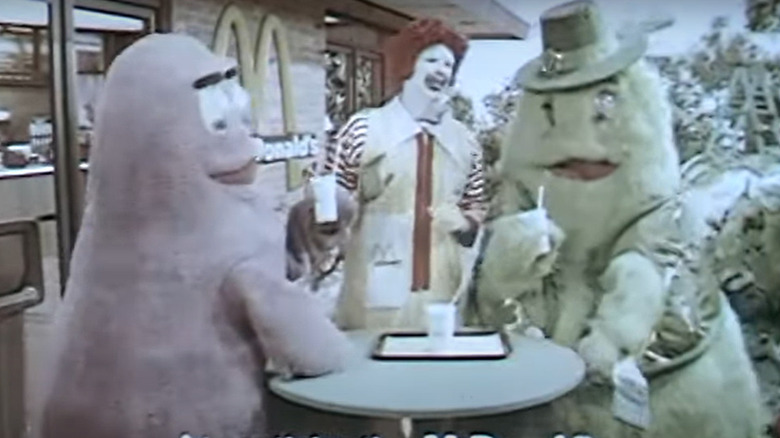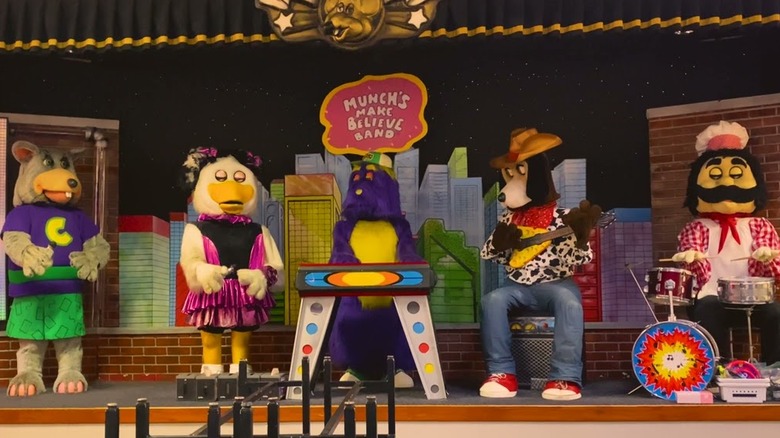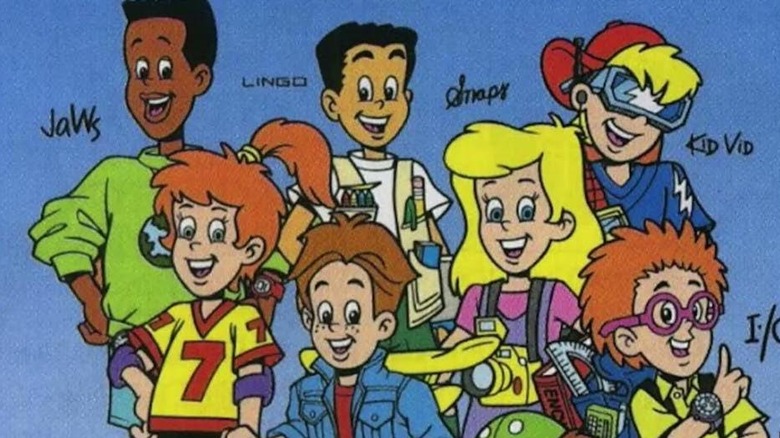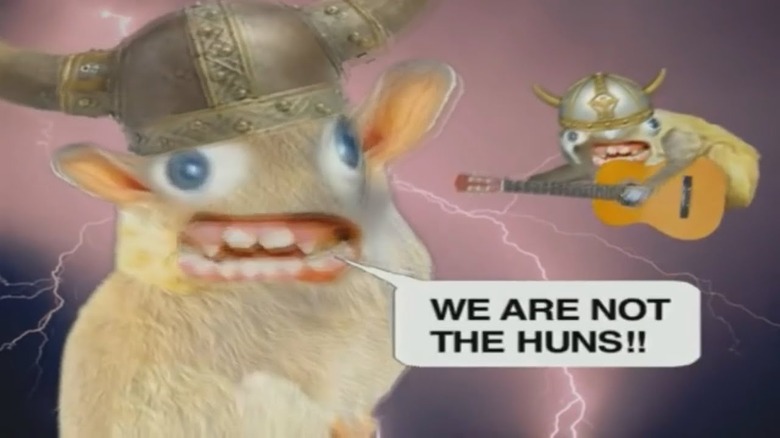The Real Reason These Popular Fast Food Mascots Vanished
Humans love fast food. And what's not to love? It's food, fast. Sure, it's typically not the healthiest option, but it's hot food that you didn't have to cook. You may not have had to even leave your car. That's a pretty good deal, and a fast food restaurant discovered in ancient Pompeii proves that the phenomenon vastly predates the founding of the first McDonald's or White Castle.
But with the wide variety of available fast food options, how will you know which drive-through to drive through? That's where marketing comes in. Fast food restaurants have featured some of the most famous, enduring, and bizarre figures in advertising history. While some, like Ronald McDonald and pals, have become iconic, others have disappeared into the mists of memory. But in recent years, even the most beloved fast food mascots have begun vanishing from TV spots and kids' meal containers. Whatever happened to these beloved figures of '70s, '80s, and '90s advertising? Read on to find out the fates of your favorite fictional fast food peddlers.
Ronald McDonald
Undoubtedly the most famous fast food mascot of all time is Ronald McDonald, the hamburger-loving clown who was the public face of McDonald's. But like many long-running corporate characters, Ronald McDonald has a weird history. He was created for the local market in Washington, D.C., when Bozo the Clown was no longer available. Over the decades, Ronald's look evolved and more and more characters were added to his world, until there was an entire McDonaldland of lovable figures selling kids French fries and milkshakes. In the '80s and '90s, these characters were ubiquitous in advertising on children's TV programming.
By 2003, Ronald and his pals had mostly been phased out as McDonald's focused their "I'm Lovin' It"-centered marketing on adults rather than children. Ronald has more or less disappeared for two major reasons: first, with fast food being increasingly linked to obesity, marketing it to children has become about as acceptable as the idea of aiming cigarette ads at them. Secondly, the view of clowns by the general public has shifted significantly in the last couple decades. Where they were once a popular and beloved source of children's entertainment, they have come to be seen as creepy at best, and a source of absolute terror at the extreme end of the spectrum. Ronald still appears at public events and in relation to the Ronald McDonald House charity, but it's unlikely you'll see him in a commercial again any time soon.
The Burger King
One of McDonald's main competitors in the burger and fries game is Burger King, and like McDonald's, Burger King introduced a fantasy land of characters designed to sell their food to kids. This world was the Burger King Kingdom, headed — naturally — by the Burger King himself. This group of characters would be phased out by the '80s, but the King himself would be reintroduced in 2004, albeit with a slightly different look and a different target audience in mind. This new King had a larger head with an unchanging creepy smile. The off-putting nature of this look was played up in a series of somewhat edgier comedy commercials meant to appeal to teens and young adults.
Despite appearing in numerous commercials and even getting his own video game, the weirder, sneakier, revamped Burger King was forced to abdicate his advertising throne in 2011. You can probably guess why: because he was too creepy and off-putting. Although some praised the King ads for their creativity and hipness, this praise didn't translate to sales. During this same period, McDonald's experienced sales success by focusing its marketing on the food, and Burger King once again decided to follow suit. The Burger King was brought back briefly in 2015 to help promote a high-profile boxing match, which, yes, everyone thought was just as weird then as it sounds now.
The Taco Bell Chihuahua
In the late 1990s, Taco Bell launched one of its most successful ad campaigns ever in the form of a chihuahua that could speak Spanish and wanted Taco Bell: In every commercial, the dog would say, "Yo quiero Taco Bell" ("I want Taco Bell"). The chalupa-loving dog appeared in dozens of commercials between 1997 and 2000 and was an absolute cultural phenomenon at that time. However, the chihuahua proved to be one of the most controversial corporate mascots in history, as various Latino advocacy groups pointed out that a Spanish-speaking chihuahua who is obsessed with tacos is actually pretty offensive. The leader of one such group told the Los Angeles Times, "To equate a dog with an entire ethnic population is outrageous, despicable, demeaning and degrading."
Ultimately, though, it wasn't complaints of racism or even boycotts over the character that got the chihuahua fired. As with most things that corporations get rid of, it's because the dog wasn't making them money. Everyone knew what Taco Bell was because of the popularity of the commercials, but a little dog with a questionable accent didn't make people want to dash to a store and scarf down a Crunch Wrap. The period featuring the "Yo Quiero Taco Bell" ads saw the biggest drop in revenue for Taco Bell to date, which led to not only Gidget the Chihuahua getting fired, but Taco Bell's CEO as well.
Mac Tonight
In 1986, McDonald's decided to take a different tack with their advertising in an attempt to draw attention to themselves as a dinner option for adults, and not just Happy Meals for kids. To that end, they introduced a new advertising campaign featuring the character Mac Tonight, a sunglasses-wearing piano player whose head was a grinning crescent moon. Mac would sit at his piano in the clouds and sing a McDonald's-themed parody of the song "Mack the Knife," a song that had been performed by many of the mid-20th century's most famous singers, including Frank Sinatra and Bobby Darin. The "Mac Tonight" version of the song was meant to appeal to Baby Boomers' nostalgia for the '50s, and the campaign was a huge success in its goals of attracting adults to eat dinner at McDonald's.
Although Mac Tonight starred in a total of 27 commercials altogether and gained global attention for the brand, the smiling moon man was put to pasture in 1989 when the estate of Bobby Darin — who had taken "Mack the Knife" to number 1 in the 1950s — sued McDonald's on the grounds that their song infringed on Darin's melody, and the look and character of Mac infringed on Darin's own appearance. McDonald's had the rights to the song "Mack the Knife," but decided not to fight the lawsuit.
Since 1989, Mac Tonight made a few appearances here and there, but the character has more recently been co-opted as imagery used by far-right groups, which means it's not likely you'll see him hawking hamburgers again any time soon.
The Noid
One of the biggest and best-known fast food mascots of the 1980s and '90s was the Noid, a claymation-based advertising figure designed to entice people to order Domino's Pizza. At a time when Domino's advertised that they could get you a hot and fresh pizza in 30 minutes or less (the lethal dangers of which are one of the most disturbing fast food secrets of all time), the Noid was a weird little dude in a red suit that represented all of the obstacles that might try to stay the valiant Domino's delivery drivers from their appointed rounds. The character was so popular that besides appearing in tons of TV spots, the Noid even had his own video games. Despite the urging of the commercials themselves, it was very difficult in the late '80s to "avoid the Noid."
The seemingly unstoppable popularity of the Noid came to an end in January 1989, when a 22-year-old man named Kenneth Lamar Noid went into a Domino's Pizza restaurant in Atlanta with a gun and took two employees hostage. Noid, it turns out, was a paranoid schizophrenic who believed that the character of the Noid was based on him, and that all the commercials were designed to taunt him. He demanded a ransom of thousands of dollars for the employees and held them for five hours, but they escaped when Noid took a break to eat a pizza. Noid was institutionalized and died by suicide in 1995. The animated Noid was quietly retired after that.
If you or someone you know is struggling or in crisis, help is available. Call or text 988 or chat 988lifeline.org
Mayor McCheese
While Ronald McDonald debuted as a solo clown character in the 1960s, by the '70s, McDonald's had introduced a whole world of characters for Ronald to inhabit in its TV commercials, a magical place that presumably smelled like beef tallow: McDonaldland. The original McDonaldland populace included Ronald, of course, but also the dark-storied Evil Grimace, who had four arms and wanted to steal milkshakes, the goblin-faced Hamburglar, the thieving Captain Crook, and the governmental figures of law and order, Mayor McCheese and Officer Big Mac.
The campaign was a huge success in getting kids' attention and McDonaldland advertisements continued until the early 2000s, but several of the original characters were phased out with a streamlining of the world of McDonaldland in the 1980s: Grimace became un-evil, the Hamburglar less goblin-like, and a girl character was introduced, Birdie the Early Bird.
Mayor McCheese and Officer Big Mac more or less disappeared following a lawsuit from children's show creators Sid and Marty Krofft, who alleged that several of the McDonaldland characters were ripoffs of their show "H.R. Pufnstuf." McDonald's lost the lawsuit, with the jury pointing out specifically that Mayor McCheese looked like Pufnstuf himself. While the official reason for their retirement has never been officially stated, it is generally speculated that the retired McDonaldland characters — including McCheese, Big Mac, and Captain Crook — were the ones that most resembled characters from "Pufnstuf."
The Burger King Kingdom
Just as their main competitor McDonald's had, Burger King introduced a world full of colorful characters to advertise their food to children in the '70s and '80s in the form of the Burger King Kingdom, which was ruled over by the original, less-creepy Burger King. The Burger King had a magic ring that would allow him to do numerous tricks, including magically summoning Burger King food, but his main antagonist was the Duke of Doubt, who tried and failed to prove that the King was faking his magic. Other characters included Sir Shake-a-lot, a knight who loved milkshakes and was always shivering because they made him cold; the Wizard of Fries, a robot powered by French fries; and the Burger Thing, a giant talking hamburger.
By the 1980s, however, it was apparent that the Burger King Kingdom couldn't match the appeal of McDonaldland, and that the Duke of Doubt would never steal kids' hearts like the Hamburglar. The ad companies decided to try to gain kids' attention in a new way, and in 1990, they moved away from the magical fantasy characters of the Burger King Kingdom to focus on the hipper, more realistic Burger King Kids Club. While the King himself would return in the 2000s in his bigger-headed, creepier, sneakier form to advertise to adults, the rest of the Kingdom has never appeared in advertising again.
Uncle O'Grimacey
While the McDonald's character Grimace was originally introduced as a sneaky purple blob who wanted to steal milkshakes, he was reworked as a happier guy who was simply Ronald's big purple pal, and his direct association with milkshakes mostly went away until the Grimace Birthday Shake (and subsequent TikTok trend) debuted in 2023. But in 1975, Grimace was still associated enough with milkshakes that when McDonald's debuted a new shake — the Shamrock Shake — they also introduced a new Grimace to help promote it. In this case, the new character was Grimace's Irish uncle, Uncle O'Grimacey. He was Grimace-shaped, but green instead of purple, and more or less dressed like a leprechaun, with a green hat and vest as well as a shillelagh. His job was to deliver Shamrock Shakes every spring.
Uncle O'Grimacey disappeared by the mid-'80s, most likely as part of the streamlining of the McDonaldland characters, but a second, much less likely theory has also been put forward. The legend — which, despite being popular, has no tangible evidence to back it up — is that in the 1980s, an actor dressed in an Uncle O'Grimacey costume and making public appearances in Philadelphia began making comments in support of the Irish Republican Army, an anti-British paramilitary group. This story is almost certainly a joke that took on a life of its own, but nevertheless, but McDonald's has said it has no plans to bring Grimace's magically minty uncle back any time soon.
Chuck E. Cheese's band
Chuck E. Cheese's Pizza Time Theatre debuted in 1977, created by Atari co-founder Nolan Bushnell, whose idea was to create a pizza parlor that combined food with the feeling of being at a carnival. It eventually evolved into a pizza arcade whose centerpiece was an animatronic band of animals led by a singing rat, inspired by Disney attractions such as the Country Bear Jamboree. The other members of Chuck's band included Mr. Munch, a purple monster guy who played keyboards; Jasper T. Jowls, a guitar-playing hillbilly hound dog; Helen Henny, a singing chicken, and Pasqually, a stereotypical Italian who plays drums.
In the '80s, Chuck E. Cheese was acquired by one of their main competitors, a pizza place with their own animatronic animal band. But what happened to the Rock-afire Explosion from Showbiz Pizza is that the Chuck E. Cheese characters proved more popular, and the Rock-afire Explosion was phased out.
However, in 2017, Chuck E. Cheese announced that they would be getting rid of the animatronics in order to modernize the look of their restaurants. Despite rumors, Chuck E. Cheese denies the idea that they got rid of the robots due to the popularity of the "Five Nights at Freddy's" franchise, which centers on murderous animatronic pizza mascots. The only location to still serve as home to Mr. Munch and crew is the restaurant's Northridge, California, store, where the band is said to have permanent residency.
The BK Kids Club
In 1990, Burger King completely moved away from their Burger King Kingdom characters in order to introduce the Burger King Kids Club, which featured a gang of cool '90s kids who featured not only in commercials, but also in newsletters and toys designed to make kids feel like part of the gang.
The multicultural club of burger enjoyers included leader Kid Vid, the technology-loving leader; I/Q, an Einstein-haired nerd; Jaws, the tall kid who loved to eat; Snaps, who loved to take pictures; Wheels, a sensitively-named wheelchair user; Boomer, the sporty one, and J.D., a dog who wore goggles. The BK Kids Club campaign proved a success, which came as something of a relief to Burger King, whose previous few ad campaigns had turned out to be unpopular with audiences and franchisees.
The Kids Club continued for the rest of the decade of the '90s, but was beginning to be phased out by 1999. The restaurant stopped calling their kids' meals Kids Club Meals and started calling them Big Kids Meals. It seems likely that the VHS-touting, rollerblading pack of '90s kids were too, well, '90s for the new millennium, so the Kids Club quietly disappeared by the early 2000s, being replaced in 2004 by a bunch of weird little animated dudes called the Honbatz, who ended up having a much shorter tenure than the Kids Club.
The Spongmonkeys
To be fair, it might be a stretch to call Quiznos' Spongmonkeys "beloved" in a universal sense. "Bemusing" might be closer to the truth, but there are certainly some out there who, for some reason, look back on them fondly. If you were watching television commercials for sub sandwiches in 2004, chances are decent that these hideous creatures are burnt into your memory.
The original version of the Spongmonkeys were created by animator Joel Veitch in 2003, for a viral video called "We Like the Moon" that had nothing to do with Quiznos. It featured two weird, messed-up monkey dudes with human eyes and mouths singing about how they liked the moon. Someone at Quiznos apparently saw that and thought, "This would be a great way to sell sandwiches." So, a reworked version of the song that praised the greatness of toasted subs aired during the Super Bowl in 2004.
The ad and its charmingly grating song certainly caught attention, and the main Quiznos office got tens of thousands of phone calls in the week following the Super Bowl. However, Quiznos franchisees hated the weird commercial with the screeching monkey things, with one Alabama shop putting up a sign denying any involvement in the ad. While Quiznos never disclosed the effect the strange ad had on their sales, the spongmonkeys were retired before the end of 2004, living on only as a strange memory for those who were kids in the early 2000s.
